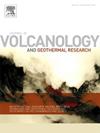A review of the differential scanning calorimetry shift–factor approach: Application to Colli Albani melt viscosity and implications for mafic Plinian eruptions
IF 2.4
3区 地球科学
Q2 GEOSCIENCES, MULTIDISCIPLINARY
Journal of Volcanology and Geothermal Research
Pub Date : 2025-01-23
DOI:10.1016/j.jvolgeores.2025.108276
引用次数: 0
Abstract
The differential scanning calorimetry (DSC) shift factor has recently been applied to model the viscosity of volcanic melts, revealing that such melts are often less viscous and more prone to nanoscale phase separation and crystallization of nanolites (i.e., nanostructuration) than previously thought.
In this study, we investigate the melt viscosity and structural evolution of the tephri–phonolite “Pozzolane Nere” (PNR) magma from the Colli Albani volcanic district (Rome, Italy), which fed one of the largest Plinian eruptions of this volcanic system. By combining viscometry, conventional and flash DSC, and spectroscopic techniques – Raman, Mössbauer, and Brillouin – we examine the melt viscosity and structure both under anhydrous and hydrous conditions.
Our results demonstrate that the PNR melt is highly susceptible to nanocrystallization, particularly during viscometry, leading to a significant increase in viscosity compared to previous estimates. Additionally, the data suggest that under pre–eruptive conditions (1050 °C and H2O = 5 wt%), the melt exhibits a viscosity one log unit lower than predicted by models. Upon dehydration, the viscosity increases remarkably, by up to 4300–fold. These findings imply that the low–viscosity behavior of PNR melt at depth could facilitate rapid magma storage and transfer through deep transcrustal magma pathways, supporting the rapid ascent needed for explosive mafic eruptions. Our results also imply that, despite this lower viscosity, the strong tendency of the PNR melt towards nanostructuration is likely to play a critical role in influencing magma rheology, as well as degassing and outgassing processes in the conduit.
These findings provide new insights into the magma storage and ascent dynamics, shedding light on how these processes may facilitate relatively rapid accumulation of mafic magmas in shallow reservoirs prior to highly explosive eruptions driven by rapid and significant crystallization.
差示扫描量热法位移因子方法综述:在科利-阿尔巴尼熔体粘度研究中的应用及其对基性普林尼火山喷发的意义
差示扫描量热法(DSC)位移因子最近被用于模拟火山熔体的粘度,揭示了这种熔体通常粘度较低,并且比以前认为的更容易发生纳米级相分离和纳米石结晶(即纳米结构)。在这项研究中,我们研究了来自意大利罗马Colli Albani火山区的“Pozzolane Nere”(PNR)岩浆的熔体粘度和结构演化,该火山区为该火山系统最大的一次普林尼火山喷发提供了岩浆。通过结合粘度法、常规DSC和闪变DSC以及光谱技术(拉曼、Mössbauer和布里色),我们检查了无水和有水条件下熔体的粘度和结构。我们的研究结果表明,PNR熔体对纳米结晶非常敏感,特别是在粘度测定过程中,导致粘度比之前的估计显著增加。此外,数据表明,在喷发前条件下(1050°C, H2O = 5 wt%),熔体的粘度比模型预测的低1个对数单位。脱水后,粘度显著增加,最多可达4300倍。这些发现表明,PNR熔体在深部的低粘度行为有助于岩浆快速储存并通过深部跨地壳岩浆通道转移,支持爆炸性岩浆喷发所需的快速上升。我们的研究结果还表明,尽管粘度较低,PNR熔体向纳米结构的强烈倾向可能在影响岩浆流变学以及管道中的脱气和放气过程中发挥关键作用。这些发现为岩浆储存和上升动力学提供了新的见解,揭示了这些过程如何促进浅层储层中基性岩浆在快速和显著结晶驱动的高爆炸性喷发之前相对快速的积累。
本文章由计算机程序翻译,如有差异,请以英文原文为准。
求助全文
约1分钟内获得全文
求助全文
来源期刊
CiteScore
5.90
自引率
13.80%
发文量
183
审稿时长
19.7 weeks
期刊介绍:
An international research journal with focus on volcanic and geothermal processes and their impact on the environment and society.
Submission of papers covering the following aspects of volcanology and geothermal research are encouraged:
(1) Geological aspects of volcanic systems: volcano stratigraphy, structure and tectonic influence; eruptive history; evolution of volcanic landforms; eruption style and progress; dispersal patterns of lava and ash; analysis of real-time eruption observations.
(2) Geochemical and petrological aspects of volcanic rocks: magma genesis and evolution; crystallization; volatile compositions, solubility, and degassing; volcanic petrography and textural analysis.
(3) Hydrology, geochemistry and measurement of volcanic and hydrothermal fluids: volcanic gas emissions; fumaroles and springs; crater lakes; hydrothermal mineralization.
(4) Geophysical aspects of volcanic systems: physical properties of volcanic rocks and magmas; heat flow studies; volcano seismology, geodesy and remote sensing.
(5) Computational modeling and experimental simulation of magmatic and hydrothermal processes: eruption dynamics; magma transport and storage; plume dynamics and ash dispersal; lava flow dynamics; hydrothermal fluid flow; thermodynamics of aqueous fluids and melts.
(6) Volcano hazard and risk research: hazard zonation methodology, development of forecasting tools; assessment techniques for vulnerability and impact.

 求助内容:
求助内容: 应助结果提醒方式:
应助结果提醒方式:


